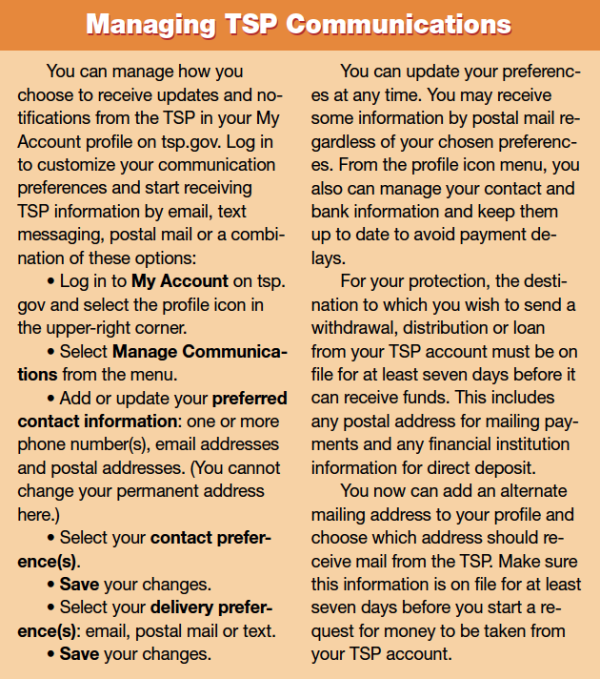Managing Your Thrift Savings Plan Investments
Three Things to Remember When Markets Keep Shifting
Typical advice about saving for retirement seems simple enough: Start saving early, contribute at least enough to get employer matching, diversify your investments, make a long-term plan and increase contributions when you can. Follow these steps and, when you get to your last day of work, you’ll have a healthy nest egg to generate the retirement income you need.
Do you know what isn’t so simple? The strong ties between money and emotions. And when you’re aware your investments are up one day and down the next (then up, then down again), that market volatility can lead to worry.
Here are three things to remember when the markets keep shifting:
1. Long-term plans beat short-term worries.
People who try to time the markets with frequent buying and selling rarely come out ahead at the finish line. The amount you contribute and your investment allocation are the most important factors affecting the growth of your TSP savings.
The biggest advantage of the TSP is your exclusive access to low-cost index funds with opportunity for broad market diversification. Index funds are designed for passive investing—that is, a buy-and-hold approach to maximize your returns over a long period. Diversification minimizes your risk as markets shift. To take advantage, you can choose to build your own TSP portfolio with individual TSP funds or let the L Funds do the work for you.
2. Stocks are “on sale” when the markets are down.
When the markets are down, each share costs less. If you’re making regular payroll contributions to your TSP account, you’re buying more shares for the same amount of money. When markets are up, share prices are higher. Keep contributing and, over time, your overall cost of each share averages out in the middle.
This is the benefit of “dollar-cost averaging,” which is much more reliable and profitable than trying to predict the perfect moments to buy or sell. In fact, the more volatile the share price, the larger the advantage of dollar-cost averaging.
3. Markets always have recovered.
Riding out market volatility is a natural part of long-term investing. Historically, stock and bond markets always have recovered and continued to grow. If you move your money out of stocks and bonds when share prices fall, you lock in your losses.
You’d also be more likely to miss the best moment to move your money back into stocks and bonds when the markets do recover. After all, in order to time short-term volatility to your advantage, you have to be able to accurately predict the future twice.'
One last thing to keep in mind: Sticking to your plan doesn’t mean you should do nothing. It’s a good idea to check in with your TSP portfolio periodically to make sure it’s still on track to meet your retirement goals. If you’re not invested in an L Fund, which rebalances for you automatically, you may want to update your allocation after gains and losses in the markets have changed your investment mix.
Or, depending on where you are in your career, you may want to adjust your investment mix to take on more or less risk. With your TSP, you have all the tools you need to manage your financial future.

How to change your TSP investments
With the recent update to My Account on tsp.gov, you’ll notice a new look with new features and tools you can use to manage your TSP savings. As part of these new features, you now have a new way to move money in your TSP account.
Previously, you had two transaction types to determine your TSP investment mix. As of June 1, 2022, you have three options to give you even more flexibility: investment election, reallocation and fund transfer.
Change your investment mix
Investment election (previously “contribution allocation”)—To specify how you want to invest new money (future contributions) going into your TSP account, including rollovers and loan payments, you’ll make an investment election. Your investment election applies to all future deposits in your account and does not affect money already in your account. When you make an investment election, you choose the percentage to go into each TSP fund. Your investment election remains in effect until you submit a new one.
Reallocation (previously “interfund transfer”)—A reallocation allows you to redistribute money already in your account among TSP funds. When you make a reallocation, you choose the new percentage you want to invest in each TSP fund. A reallocation only affects your current account balance. When you make a reallocation in My Account, you’ll see a prompt that asks if you also want to apply the reallocation percentages to your investment election.
Move money among funds
Fund transfer (new option)—The new fund transfer option allows you to move money from one or more specific funds to another specific fund or funds without affecting the rest of your account. Fund transfers also are how you can move money to and from the new mutual fund window if you choose to use that option. When you request a fund transfer, you can specify a percentage or dollar amount to move.
Remember: Reallocations and fund transfers are limited. Each calendar month, your first two reallocations or fund transfers may be used to redistribute money in your TSP account. After the first two of either type of transaction in a calendar month, you only can move money into the TSP G Fund. If you have both a civilian and a uniformed services account, these rules apply to each account separately.
Find out more information about TSP investments and investment options at tsp.gov.
.png?resize=600x0)
